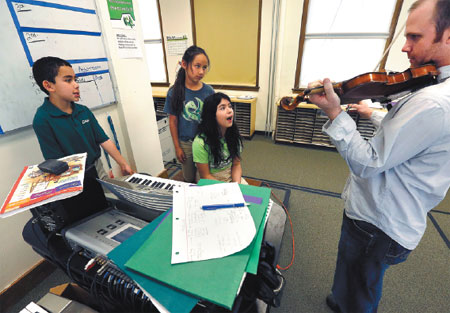 |
|
John Hilton, a violinist with the Colorado Symphony Orchestra and a teacher with the Very Young Composers program, helps students compose during music class at Cole Elementary in Denver.
|
Denver Mayor Michael Hancock released a report that includes the survey and stresses that increasing access is crucial because of the economic importance of the arts and changing demographics: About a third of the city's population is Hispanic, and more than half its population growth over the last 20 years has been among Hispanics.
Museums, theaters and galleries employ 10,000 people in metropolitan Denver, according to the Colorado Business Committee for the Arts. Neither the committee nor the city could provide the number of blacks and Hispanics with such jobs.
Jerome H. Kern, CEO and co-chair of the board of the Colorado Symphony Orchestra, jokes that his is "an organization that has an aging white audience, that plays dead, white man's music and is supported by a lot of rich white people". He acknowledges the symphony, which is supported by tax dollars as well as donors, has long talked about diversity while taking little action.
That's changing, with mash-ups that bring performers like Reeves to the symphony hall. Classically trained musicians are also getting out of the hall to visit neighborhoods where black and other Denverites complain cultural offerings are scant. One pilot project has Colorado Symphony Orchestra musicians working with the University of Denver's Playground Ensemble to make composers out of students at an inner-city elementary school.
It can take a shock to get an old-guard institution to change, says JJ Rutherford, education director at Colorado History, which hosts a museum and state archives. For hers, it was the move to a new building in 2011. The excitement of having a new home fostered new thinking. Curators reached out to churches and community and business groups to tell a more inclusive story about Colorado's cultures. The museum even hosted a naturalization ceremony this year.
"That's the community we need to be relevant to," Rutherford recalled thinking as she watched new US citizens from Bhutan, Pakistan, Vietnam and elsewhere take the oath.
The outreach is crucial to convincing voters to renew the SCFD, which has distributed more than $750 million since it was created, says Peg Long, the organization's executive director.
In preparing for the next vote in 2016, Long says the district is doing something it did not do the two previous times it was re-authorized: canvassing the organizations it funds for ideas on how it might operate, rather than leaving all the discussion to its board.
"The time is now for our major arts institutions to start implementing input from the community and the audiences they are trying to recruit, and not just talk about it," says Antonio Mercado, an actor, director, theater professor and former member of the city's cultural affairs commission.
We Recommend:
